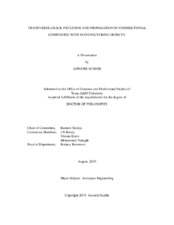| dc.contributor.advisor | Talreja, Ramesh | |
| dc.creator | Sudhir, Aswathi | |
| dc.date.accessioned | 2019-11-20T23:08:12Z | |
| dc.date.available | 2019-11-20T23:08:12Z | |
| dc.date.created | 2019-08 | |
| dc.date.issued | 2019-07-01 | |
| dc.date.submitted | August 2019 | |
| dc.identifier.uri | https://hdl.handle.net/1969.1/186257 | |
| dc.description.abstract | The objective of the current work is to study damage initiation and propagation in unidirectional fiber-reinforced polymeric composites under transverse loading. In the study conducted, a systematic analysis is carried out to analyze the effects of manufacturing induced defects such as random distribution of fibers and presence of voids in matrix on the damage initiation in unidirectional composites under transverse tension. As illustration, this study focuses on the resin infusion manufacturing process and the defects hence formed. Upon infusing resin, the initial fiber configuration undergoes perturbation and results in a random distribution with regions of resin rich areas and fiber clusters. In addition, micro voids (between the fibers in a bundle) and macro voids (between fiber bundles) are usually formed from the manufacturing process. Effort is laid on quantifying the effect of manufacturing defects to the failure events. Representative Volume Elements (RVEs) are constructed to capture essential features of the composite microstructure that determine the local stress fields and hence damage initiation followed by further events of damage. Stress analysis of the RVEs is conducted using Abaqus FEA software. A novel methodology is put forward to generate random distributions of fibers that would simulate different levels of perturbations of the fibers from initial (dry bundle) positions during the manufacturing process resulting in different configurations of fiber clusters. An embedded RVE approach has been adopted in a finite element model to calculate the stress fields to avoid artificial effects of the RVE boundary. Damage initiation is then monitored using a previously proposed energy based criterion for cavitation induced fiber/matrix debonding in polymers. The first event of failure is determined by the energy based criterion.
This work also throws light on the significance of energy based failure initiation in polymeric composites. The local stress field determines the first failure event out of the two competing mechanisms- dilatation driven and distortional driven. Subsequent events of damage in the form of crack formation by coalescence of the debond cracks is also analyzed by the energy based approach. The cavitation based damage initiates in the matrix region close to the fiber matrix interface and results in debond formation. These debonds coalesce to form cracks of different length based on the number of fibers debonding. The energy released during the crack growth is monitored for increasing crack length and the criticality is compared to homogeneous case at different crack lengths. The strains at cracking are monitored for varying radial mobility. The effect of non-uniformity in fiber distribution is gauged by comparing the total J Integral of the RVEs with homogeneous and matrix medium. Ongoing and future work is aimed at studying ply cracking process to its full extent and its consequence on crack deflection into inter-ply regions leading to delamination. | en |
| dc.format.mimetype | application/pdf | |
| dc.language.iso | en | |
| dc.subject | damage initiation | en |
| dc.subject | composite materials | en |
| dc.subject | effect of manufacturing defects | en |
| dc.title | Transverse Crack Initiation and Propagation in Unidirectional Composites with Manufacturing Defects | en |
| dc.type | Thesis | en |
| thesis.degree.department | Aerospace Engineering | en |
| thesis.degree.discipline | Aerospace Engineering | en |
| thesis.degree.grantor | Texas A&M University | en |
| thesis.degree.name | Doctor of Philosophy | en |
| thesis.degree.level | Doctoral | en |
| dc.contributor.committeeMember | Kinra, Vikram | |
| dc.contributor.committeeMember | Naraghi, Mohammed | |
| dc.contributor.committeeMember | Reddy, J . N. | |
| dc.type.material | text | en |
| dc.date.updated | 2019-11-20T23:08:12Z | |
| local.etdauthor.orcid | 0000-0001-9580-288X | |


